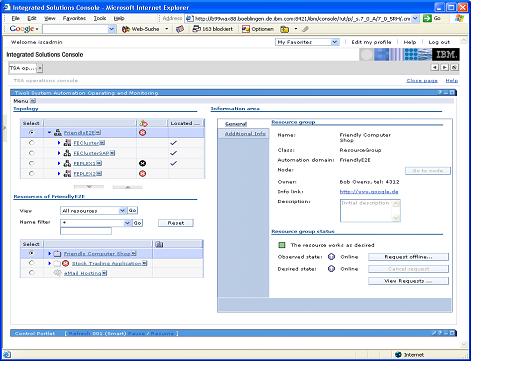| Tool Mentor: SA - Execute IT Service Continuity Plan |
 |
|
| Related Elements |
|---|
ContextTool mentors explain how a tool can perform tasks, which are part of ITUP processes and activities. The tasks are listed as Related Elements in the Relationships section. You can see the details of how processes and activities are supported by this tool mentor, by clicking the links next to the icons: DetailsIBM® Tivoli® System Automation family of products helps automate the IT Service Continuity Plan by providing the ability to restore application, middleware and hardware resources after an incident such as a temporary loss of power. Additionally, the System Automation family, as a key element of IBM GDPS offerings, also provides complete disaster recovery functionality including the ability to restart critical applications and move workload to a remote location in the event a primary site is lost. The IBM Tivoli System Automation family of products includes:
Business Continuity Planning (BCP) is an enterprise-wide planning process that creates detailed procedures to be used in the case of a large unplanned outage or disaster. Maintaining continuity of business processes is the overall objective. Disaster Recovery Planning (DR Planning) is a logical subset of the BCP process, which focuses on continuity of IT operations. Business continuity is achieved through rigorous planning, strategy, and process development. Part of the BCP planning process quantifies the critical business processes, the cost of downtime, and the risks that an organization faces. The risks help to justify the means by which an organization builds availability, disaster tolerance, and disaster recovery capability into the IT infrastructure. The supporting IT infrastructure is closely associated with the Disaster Recovery Planning process. Examples of costs to consider are: direct revenue loss, regulatory agency / IRS penalties, market share loss, and employee downtime. IBM Tivoli System Automation family of products adds high availability and disaster recovery capabilities to your IT infrastructure to ensure automated service continuity. These products provide fast detection of outages and quick recovery of failed software and hardware resources either in place or on another system without operator intervention. For example, IBM Tivoli System Automation maintains availability of business applications running in a UNIX® server cluster. When the primary server experiences a temporary, unplanned outage, IBM Tivoli System Automation recovers the application by restarting it in place, if possible, or recovering the application on a standby server in the cluster. Service interruption is almost imperceptible to the application end user. IBM Tivoli System Automation also provides high availability of critical applications in more complex environments, such as multi-tiered application environments where, for example, the business application runs in a UNIX server cluster and is connected to a database in a mainframe Parallel Sysplex cluster. If the database experiences a temporary outage, IBM Tivoli System Automation recovers the database on another server in the Sysplex, and restarts the business application in the UNIX cluster to reconnect the application to the database and prevent the overall system from hanging. With IBM Tivoli System Automation, unplanned downtime is reduced from several hours to a momentary delay.
IBM GDPS offerings ensure business continuity in the event of a major disaster that can bring down an entire data center. In IBM GDPS offerings, IBM Tivoli System Automation provides recovery of critical applications and helps automate the entire recovery process from a single point of control, while other elements including IBM TotalStorage provide data recovery. GDPS offerings provide the ability to effectively recover critical business applications and data from the operations site to a remote backup site that mirrors the operations site. For example, if the primary site suffers an outage, GDPS shifts the workload, including the critical applications and the data, to the backup site so the business can continue to operate. GDPS can recover IT services in minutes or hours, compared to days, weeks or even months for manual recovery processes. For More InformationFor more information about this tool, click on the link for this tool at the top of this page. |
©Copyright IBM Corp. 2005, 2008. All Rights Reserved. |
